Medieval Indian History MCQs
Multiple choice questions on Medieval Indian History for General Studies and GK preparation of SSC, NDA, CDS, UPSC, UPPSC and State PSC Examinations.
1. Which among the following was the single biggest item of import to the Vijayanagar empire?
[A] Precious stones
[B] Horses
[C] Luxury goods
[D] Raw Silk
Show Answer
Correct Answer: B [Horses]
Notes:
Kings of Vijayanagar, imported Arabian horses on a large scale, in order to improve the breed of cavalry horses in their own districts. Thus, the single biggest item of import to the Vijayanagar empire was Horses.
2. The most important reason for collection of “Chauth” and “Sardeshmukhi” by Marathas was __?
[A] To increase the source of income
[B] To expand his territories
[C] To consolidate his political influence
[D] Because of the opposition of Muslim rulers
Show Answer
Correct Answer: A [To increase the source of income]
Notes:
Shivaji collected the chauth and sardeshmukhi from the territory which was either under his enemies or under his own influence. The chauth was one fourth part of the income of a particular territory while the sardeshmukhi was one tenth. Shivaji collected these taxes simply by force of his arms. These constituted of the primary sources of income of Shivaji and helped in the extension of the power and territory of the Marathas.
3. Who among the following is considered to be the teacher of Amir Khusro?
[A] Moinuddin Chishti
[B] Baba Farid
[C] Nizamuddin Auliya
[D] Bakhtiyar Kaki
Show Answer
Correct Answer: C [Nizamuddin Auliya]
Notes:
Amir Khusrau was an influential poet who embraced Sufism under the guidance of Nizamuddin Auliya in 1310 during reign of Alauddin Khilji. In his prolific career, he wrote several significant works. One of them was Nuh Sipihr, a masnavi about the reign of Sultan Qutb ud-Din Mubarak Shah Khalji. Another noteworthy work was Duval Rani – Khizr Khan, a love saga about the alliance between Vaghela princess Duval Rani and Khizr Khan, the progeny of Sultan Ala ud-Din Khalji.
4. Moti Masjid was built in Red Fort by which of the following Mughal Emperor?
[A] Shahjahan
[B] Aurangazeb
[C] Shah Aalam II
[D] Akbar
Show Answer
Correct Answer: B [Aurangazeb]
Notes:
Moti Masjid is a mosque built in Red Fort. It was built by Aurangzeb in 1659 for his second wife. It was used by the ladies of the Zenana.
5. Which among the following is not a work of Amir Khusrau?
[A] Khazyan-ul-Futuh
[B] Tughluq Nama
[C] Tarik-i-Alai
[D] Tabqat-i-Naisiri
Show Answer
Correct Answer: D [Tabqat-i-Naisiri]
Notes:
Tabaqat-i Nasiri (named after Sultan Nasir-ud-Din) is a mega history of Islamic world writen in Persian by Minhaj-i-Siraj. It gives details of early Islamic empires in 23 volumes.
6. Who among the following was the first writer to use Urdu as a medium of poetic Expression?
[A] Amir Khusaru
[B] Mirza Ghalib
[C] Bahadur Shah Zafar
[D] Faiz
Show Answer
Correct Answer: A [Amir Khusaru]
Notes:
Amir Khusrau was a Sufi singer, poet and scholar. He was an iconic figure in the cultural history of the Indian subcontinent. He was a mystic and a spiritual disciple of Nizamuddin Auliya of Delhi.
7. Who among the following is the Persian mathematician and poet composer of the world famous Rubbayat?
[A] Omar Khayyám
[B] Muhammad Iqbal
[C] Sultan Bahu
[D] Mirza Ghalib
Show Answer
Correct Answer: A [Omar Khayyám]
Notes:
Rubbayat is written by Omar Khayyam. It is collection ruba i.e .persian poems.
8. In the name of which among the following Mughal emperors, the East India Company struck the first coins in India?
[A] Jahangir
[B] Farrukhsiyar
[C] Muhammad Shah
[D] Jahandar Shah
Show Answer
Correct Answer: B [Farrukhsiyar]
Notes:
The Farrukhsiyar royal farman of 1717 had allowed the company to mint its own coins. Thus, he was the Mughal King in whose name, East India Company minted its own coins.
9. Ekamabaranadhar temple of Kanchipuram in Tamil Nadu was built by__?
[A] Cholas
[B] Pandyas
[C] Pallavas
[D] Vijayanagar Emperors
Show Answer
Correct Answer: D [ Vijayanagar Emperors ]
Notes:
Kanchipuram is known as the “city of a thousand temples. The 192 feet high temple tower of Ekamabaranadhar temple and the 100-pillar mandabam (building) in Varadaraja Perumal temple in this town are famous, and are considered marvels of the architectural techniques of the Vijayanagara dynasty.
10. Which among the following markets were introduced by Allauddin Khilji?
[A] Sahna-i-mandi and Sarai Adl
[B] Market for slaves
[C] Market for horses and cattle
[D] All of the above
Show Answer
Correct Answer: D [All of the above]
Notes:
In context of the economic reforms of Allauddin Khilji, he introduced three types of markets viz. Sahna-i-mandi (grain market), Sarai Adl (cloth and groceries market) and Market for horses, cattle and slaves.

